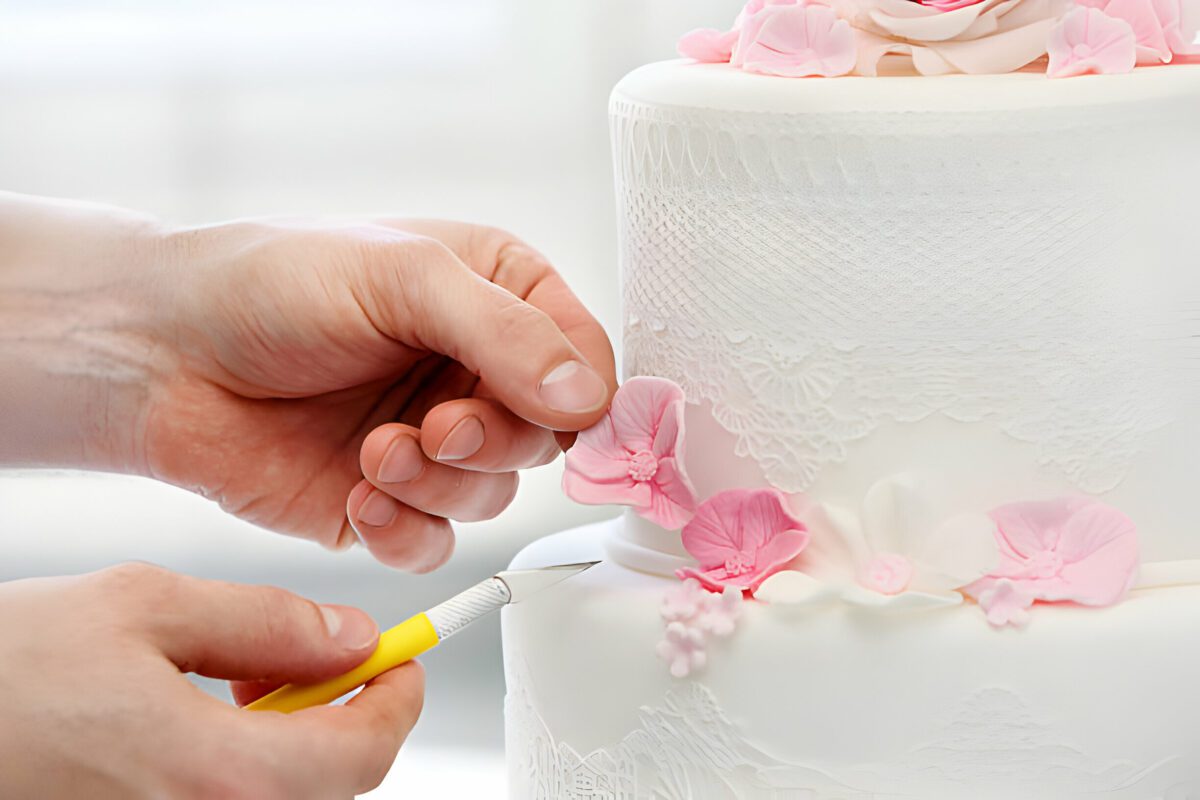What is Cake Decorating Terminology?
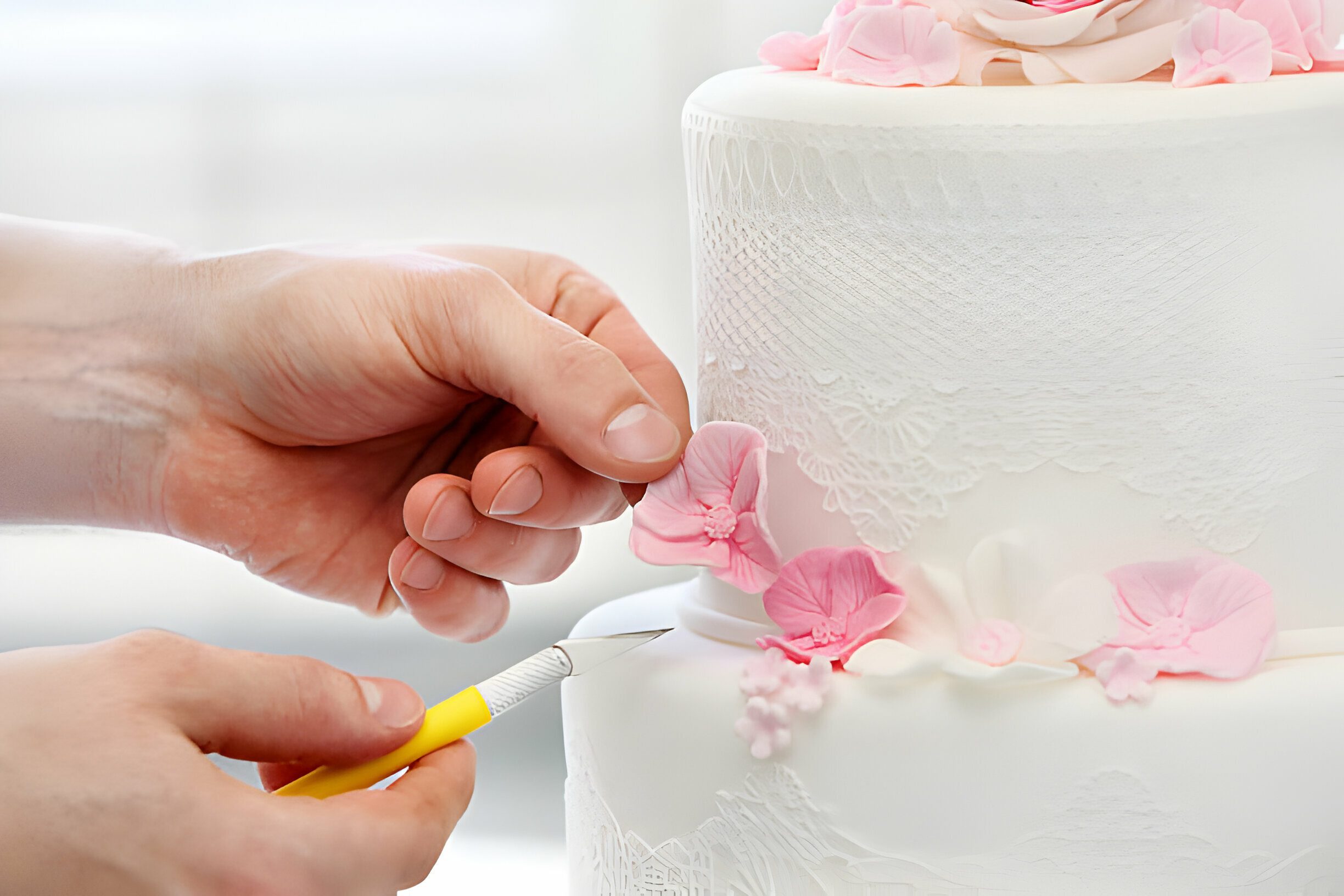
Definition of Cake Decorating Terminology
Cake decorating terminology comprises the specialized vocabulary used by baking aficionados and professionals alike. This lingo includes names of techniques, tools, and ingredients specific to the art of cake design. Understanding these terms ensures that when a recipe mentions “fondant”, “ganache”, “buttercream”, “piping”, or “crumb coating”, you know precisely what is expected without second-guessing. In order to improve your cake decorating skills and expand your knowledge of terminology, it can be helpful to invest in some of the best cupcake decorating books on the market. These books often include detailed explanations and step-by-step instructions for various techniques, as well as tips for using different tools and ingredients. By familiarizing yourself with these resources, you can become more confident and proficient in the art of cake design.- Fondant: A pliable sugar paste used for coating cakes
- Ganache: A mix of chocolate and cream used as a glaze or filling
- Buttercream: A creamy mixture of butter and powdered sugar for icing or filling cakes
- Piping: The act of squeezing icing through a piping bag to create designs
- Crumb Coating: A thin layer of frosting applied to trap crumbs before the final coat of icing
Importance of Understanding Cake Decorating Terminology
Delving into cake decorating is more than whipping up a tasty batter. Knowing the terminology forms the foundation of your cake decorating skills, enabling you to follow recipes accurately and communicate effectively with peers in the baking community.- Prevents Missteps: With correct terminology, you avoid common errors that can arise from misinterpreting a technique or using the wrong ingredient.
- Boosts Creativity: Familiarity with various terms inspires you to try new decorating techniques, expanding your creative possibilities.
- Enhances Efficiency: Speaking the language of cake artistry streamlines the learning process, helping you to pick up new methods and use tools more efficiently.
- Encourages Professionalism: Professional environments value clear and accurate use of terminology, showcasing your expertise and attention to detail. By integrating the relevant vocabulary into your baking practice, you pave the way for more elaborate and impressive cake designs. Each term you learn is an essential ingredient in the recipe for your ongoing development as a cake artist.
Common Cake Decorating Terms
Fondant
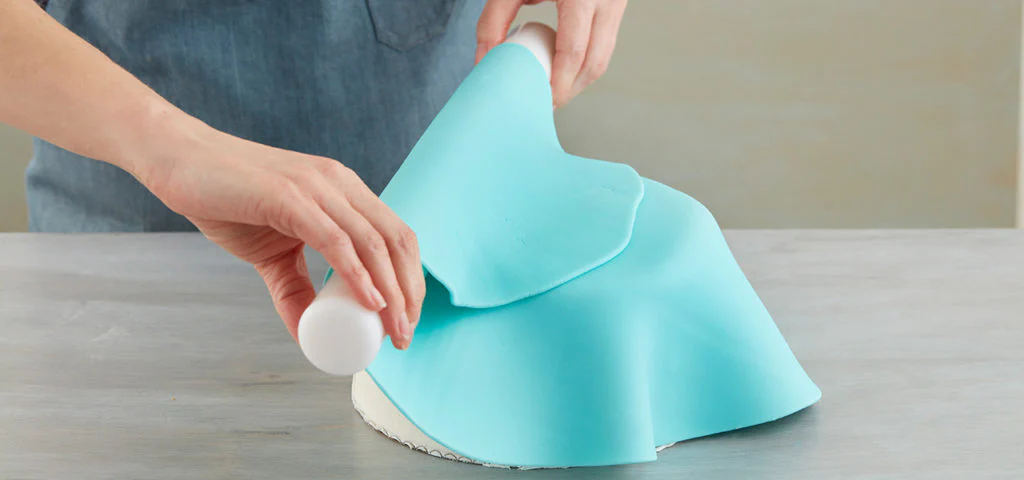 Fondant is a pliable, dough-like icing that you can roll, shape, and mold to achieve a smooth, professional finish on cakes. Known for its versatility, fondant is used to create a variety of decorative shapes and figures. Key characteristics include its elasticity and ability to be colored or flavored to match your design demands. To work with fondant effectively:
Fondant is a pliable, dough-like icing that you can roll, shape, and mold to achieve a smooth, professional finish on cakes. Known for its versatility, fondant is used to create a variety of decorative shapes and figures. Key characteristics include its elasticity and ability to be colored or flavored to match your design demands. To work with fondant effectively:
- Always knead before rolling to eliminate air bubbles and achieve a uniform texture.
- Use cornstarch or powdered sugar to prevent sticking on surfaces.
- Roll out to a thickness of about 1/8 to 1/4 inch for best application.
Buttercream
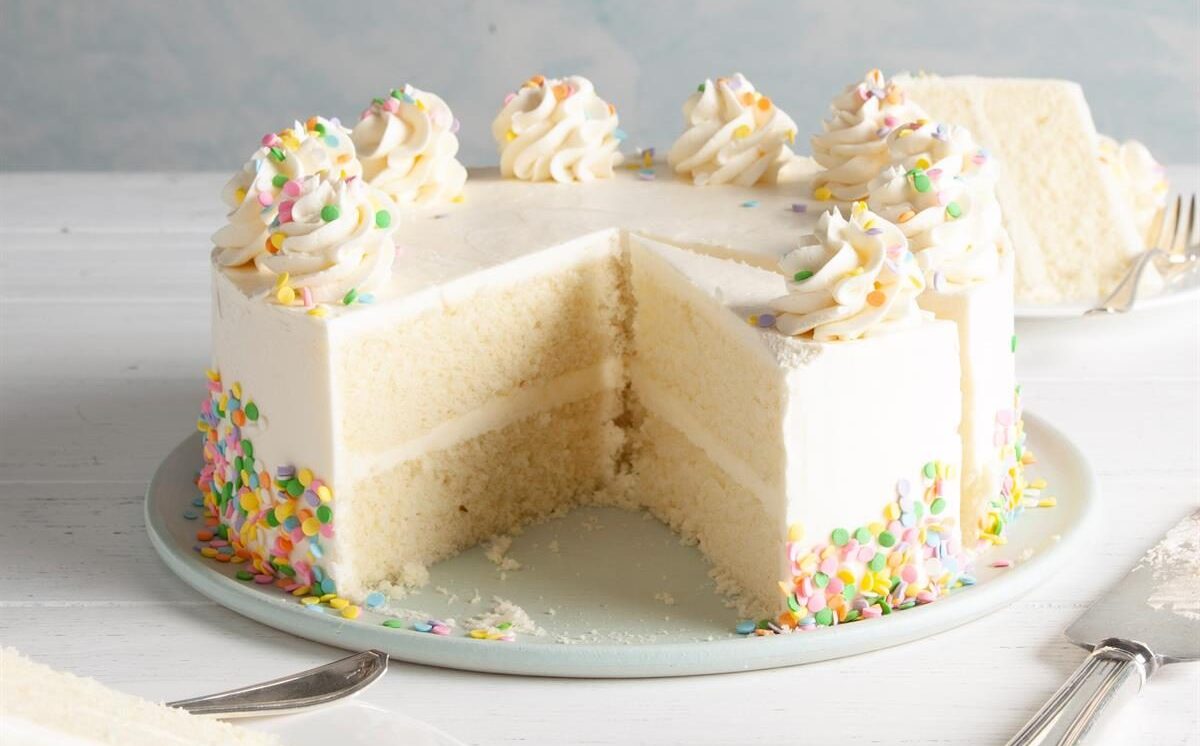 Buttercream is a creamy frosting that’s ideal for both filling and coating cakes. It provides a rich flavor and is easier to manipulate than fondant for textured designs. There are several types of buttercream, including:
Buttercream is a creamy frosting that’s ideal for both filling and coating cakes. It provides a rich flavor and is easier to manipulate than fondant for textured designs. There are several types of buttercream, including:
- American Buttercream: Known for its sweet, fluffy texture made from powdered sugar and butter.
- Italian Meringue Buttercream: A smoother, silkier variant made with whipped egg whites and sugar syrup.
- Swiss Meringue Buttercream: Similar to the Italian but with a cooking method that involves dissolving sugar into egg whites before whipping.
- Achieve the right consistency by adjusting the amount of liquid or powdered sugar.
- Consider ambient temperature as buttercream can melt or stiffen depending on the heat.
Piping
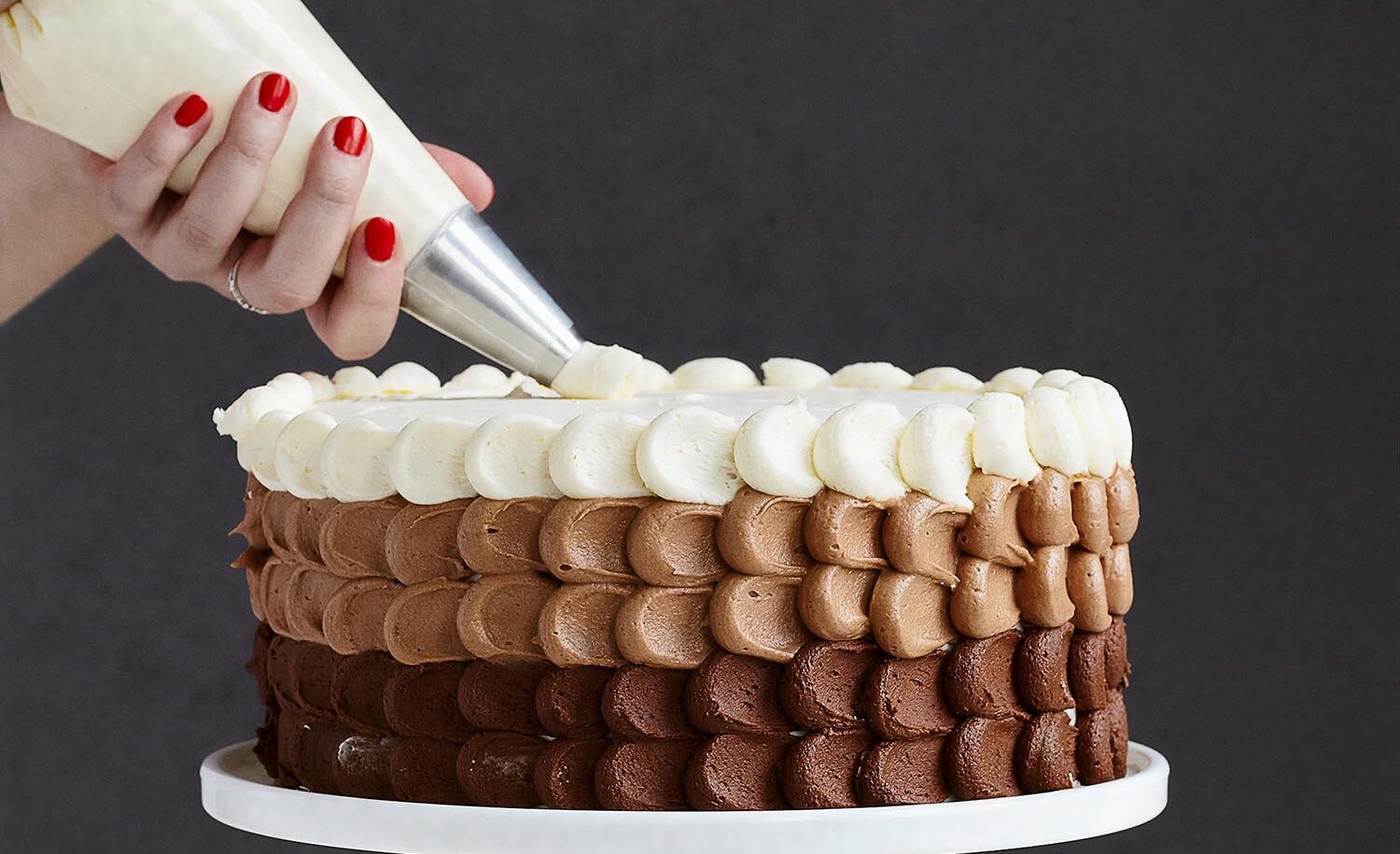 Piping is the art of squeezing icing through a nozzle to create decorative patterns on cakes. Mastery of piping techniques can elevate your decorating skill set. Important tools and tactics include:
Piping bags: Essential tools made from cloth, paper, or plastic that you fill with icing.
Piping tips: Various shaped nozzles that attach to the bag’s end, each providing a different design outcome such as stars, flowers, or writing.
When piping:
Piping is the art of squeezing icing through a nozzle to create decorative patterns on cakes. Mastery of piping techniques can elevate your decorating skill set. Important tools and tactics include:
Piping bags: Essential tools made from cloth, paper, or plastic that you fill with icing.
Piping tips: Various shaped nozzles that attach to the bag’s end, each providing a different design outcome such as stars, flowers, or writing.
When piping:
- Apply consistent pressure to the bag for uniform designs.
- Practice the design on parchment paper before applying to the cake.
- Clean the tip regularly to prevent clogging and ensure sharp patterns.
Types of Cake Decorations
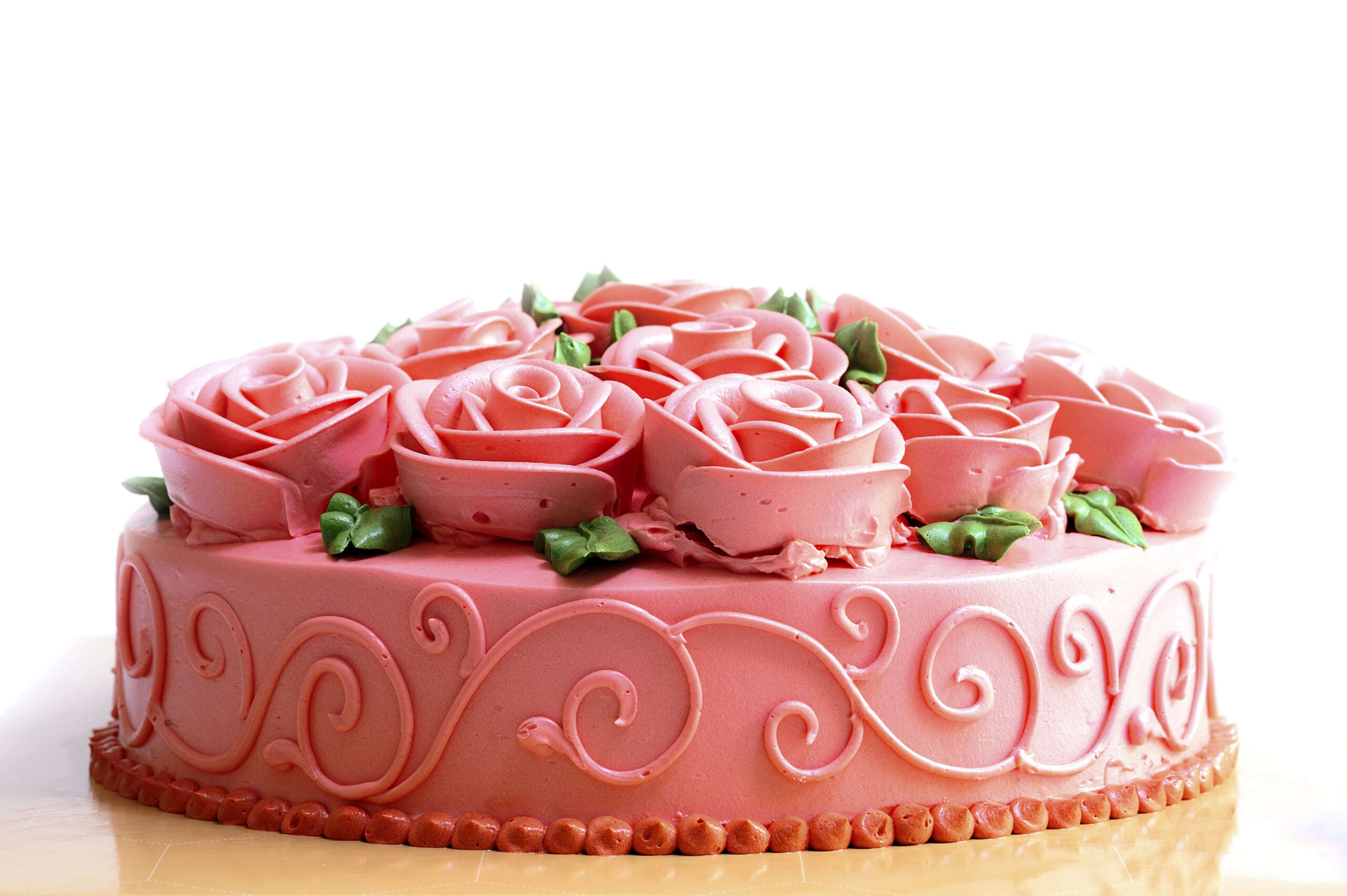 Decorating a cake requires knowledge of different techniques and materials to create a visually appealing dessert. In your cake decorating journey, you’ll come across various decoration types that can transform a simple cake into a work of art.
Decorating a cake requires knowledge of different techniques and materials to create a visually appealing dessert. In your cake decorating journey, you’ll come across various decoration types that can transform a simple cake into a work of art.
Borders and Edges
Adding borders and edges to your cakes is a fundamental technique that serves as a finishing touch, often concealing imperfections where the cake layers meet the icing. When aiming for perfect borders, you have several options:- Shell Borders: Created with a star piping tip, shell borders offer a classic look with their rounded, repeating pattern.
- Rope Borders: Twisted in appearance, rope borders are fashioned with a special twisting motion of the piping bag to give the illusion of a braided edge.
- Bead Borders: Frequently used for elegance, bead borders, made with a round piping tip, resemble a string of pearls around the cake’s base.
Flowers and Sprays
Flowers and sprays can turn an ordinary cake into a stunning centerpiece. These decorative elements range from simple buttercream flowers to intricate sugar-paste creations. To create beautiful flowers, here are essential techniques to consider:- Buttercream Flowers: Use various piping tips and a flower nail to pipe flowers directly before transferring them onto the cake.
- Fondant or Gum Paste Flowers: For a more durable option, roll out fondant or gum paste, cut out petal shapes, and assemble them into naturalistic flowers.
- Royal Icing Flowers: Ideal for making in advance, these flowers are piped and allowed to harden, providing a crisp, delicate addition to any cake.
Sculpted and 3D Cakes
Sculpted and 3D cakes take cake artistry to new heights, requiring structural know-how and a creative approach. To embark on creating sculpted cakes, you’ll need to:- Understand Cake Stability: Dense cakes such as pound cakes work best for carving and sculpting. They can handle the manipulation without crumbling.
- Build a Strong Foundation: Use dowels and cake boards strategically to support the cake’s structure, especially if working with multiple tiers or complex shapes.
- Master Modeling: Learn to shape fondant, modeling chocolate, and gum paste to create figures and 3D elements that bring your imaginative designs to life.
Essential Cake Decorating Techniques
Crumb Coating
Crumb coating is a crucial step in cake decorating. It involves spreading a thin layer of frosting over the entire cake to seal in crumbs before applying the final layer of icing. This acts as a foundation, ensuring your cake has a smooth, crumb-free surface. Here’s how you perform a flawless crumb coat:- Chill your cake layers to reduce crumbs.
- Apply a thin layer of buttercream with an offset spatula.
- Smooth out with a cake scraper.
- Let the coat chill until it’s set; usually about 15 to 30 minutes in the refrigerator.
Baking and Leveling
Baking a perfect cake comes down to precision and technique. Here are the steps you need to follow for the best results:- Use the Right Measuring Tools—spoons for liquid and cups for dry ingredients.
- Always Preheat Your Oven to the correct temperature before baking.
- Fluff and Spoon Dry Ingredients into the measuring cups then level off with a straight edge.
- Ensure even baking by rotating your cake halfway through the cooking time.
- Check for doneness with a toothpick; if it comes out clean, it’s ready.
- Cool cakes completely before leveling. Use a serrated knife to trim off the domed tops for a flat surface.
Airbrushing
Airbrushing adds a professional touch to your cake decorating skills. It uses a small, air-operated tool to spray food coloring onto the cake, offering unparalleled smoothness and gradation in color. To master airbrushing, you’ll want to know:- Always Start with a Base – Ensure your cake is coated with a fondant or a crumb-coated buttercream layer.
- Choose the Right Colors – High-quality, liquid airbrush colors are designed to be thin and even.
- Test First – Practice your technique on a paper towel.
- Gradual Layers – Build up color intensity gradually to avoid drips.
Tools and Equipment for Cake Decorating
Piping Bags and Tips
Your cake decorating toolkit isn’t complete without piping bags and tips. These are essential for creating a variety of designs, from delicate flowers to elegant lettering. Piping bags come in disposable and reusable options. Disposable bags offer convenience, while reusable bags are eco-friendly and may save you money in the long run. The selection of piping tips is vast, but there are some must-haves:- Round tips for writing and making dots
- Star tips to create stars and rosettes
- Leaf tips for realistic foliage
- Petals tips to shape flowers and ruffles
Cake Spatulas and Smoothers
Cake spatulas and smoothers are indispensable for achieving a flawless finish on your cakes. Spatulas come in two main types: the offset spatula for spreading filling layers evenly and the straight spatula for applying frosting to the sides of the cake. Both types play a critical role in layering and frosting:- Offset spatulas assist with precise spreading, especially in hard-to-reach areas.
- Straight spatulas are ideal for achieving a smooth side finish.
- Edge smoothers perfect the corners and edges of a square or rectangular cake.
- Surface smoothers polish the top and sides for an even canvas.
Fondant Rolling Pins
Essential for working with fondant, fondant rolling pins are specifically designed to roll out this pliable sugar dough evenly. They are typically made from non-stick materials like silicone or plastic and come in various sizes. Small rolling pins are perfect for detailed work, while larger ones are suitable for covering bigger cakes. To ensure the best results:- Use non-stick rolling pins to prevent fondant from sticking
- Opt for pins with guides to achieve an even thickness
- Select the right size for the project at hand
Cake Decorating Tips and Tricks
Quick and Easy Cake Decorating Ideas
When you’re short on time but want to create a visually stunning cake, consider these quick and simple decorating ideas:- Use Pre-Made Decorations: Edible flowers, sprinkles, and pre-made sugar decorations can add instant flair.
- Stencils: Lay a stencil over your cake and dust with powdered sugar or cocoa powder for an elegant design.
- Edible Paint: Brush metallic edible paint on fondant for a touch of glamour.
- Fruit Toppers: Crown your cake with a vibrant arrangement of fresh fruits for a minimal yet refreshing look.
Achieving Smooth Buttercream Finishes
To achieve a smooth buttercream finish that’s bakery-worthy, follow these tips:- Room Temperature Butter: Ensure your butter is at room temperature for a silkier, smoother buttercream.
- Consistent Mixing: Beat the buttercream on medium speed for 3 to 5 minutes for even consistency.
- Use a Bench Scraper: Glide a bench scraper across the buttercream to level and smooth the sides.
- Hot Water Method: Dip your spatula in hot water, dry it, and then smooth out the buttercream; the heat helps eliminate lines and imperfections.
Adding Texture to Fondant
Revamping fondant with texture gives your cake a sophisticated edge. Here’s how to achieve that:- Embossing Mats or Rollers: Press an embossing mat or roller onto rolled-out fondant for an instant intricate pattern.
- Textured Rolling Pins: Opt for a textured rolling pin to imprint continuous designs with ease.
- Modeling Tools: Use modeling tools to create custom textures or details in specific areas.
- Hand-Crafting: Shape and press fondant manually, mimicking natural textures like ruffles or pleats.
Are Pie Baking Tips Applicable to Cake Decorating?
When it comes to cake decorating, some of the top pie baking tips can be surprisingly applicable. For example, using a light hand when mixing ingredients can prevent tough textures in both pies and cakes. Additionally, controlling the oven temperature is crucial for achieving the perfect golden crust or moist interior.

